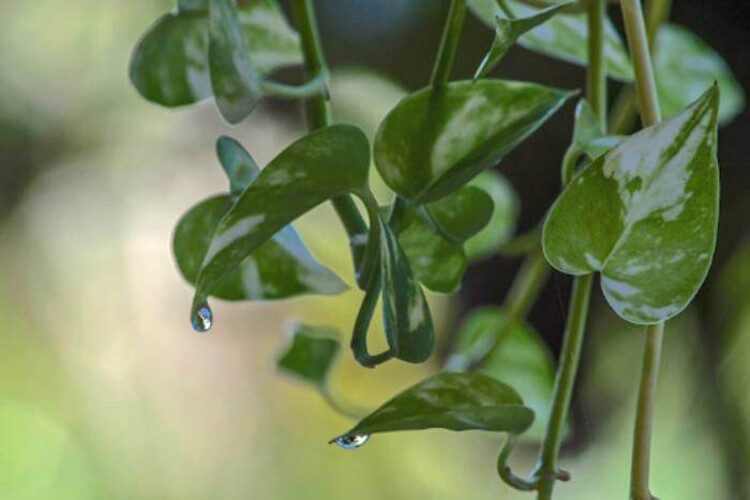Sign up for our newsletter
Get Swipe Garden's independent reviews, and expert advice sent straight to your inbox.
For information privacy practices, read our Privacy Policy.
Sign up for our newsletter
Get Swipe Garden's independent reviews, and expert advice sent straight to your inbox.
For information privacy practices, read our Privacy Policy.
Sign up for our newsletter
Get Swipe Garden's independent reviews, and expert advice sent straight to your inbox.
For information privacy practices, please read our Privacy Policy.

If you observe the droplets on the Pothos plants, it might be water dripping through the leaves. If this problem happens, it’s either because of the high humidity outside or because you’ve overwatered it. After a few days of receiving less water, your Pothos should eventually stop transpiring. So, let’s find out why water dripping happens and remedies for it in this article.
At times, Pothos plants’ leaf tips will emerge with water droplets. This occurrence is frequently described as sweating or water-dripping leaves. The scientific term for this phenomenon is “guttation.” Your plants may appear to be crying or sweating, but they’re only releasing excess moisture. The hydathodes, or water glands, on the tips of these houseplants’ leaves are how the plants get rid of unwanted moisture. Consider Pothos’s problem if you want to know deeply why Pothos leaves dripping water. Let’s scroll down the post right now!
For houseplants like Pothos, overwatering already poses a danger because it can cause root rot and ultimately cause the plant to die. If you try to provide your plants with more moisture than they require, you will increase the pressure in their rhizome systems.
It makes the plants strive to expel the surplus dampness from their leaves by removing additional moisture via the sweat glands, or hydathodes, on their leaves. Even when you only provide a small amount of moisture to the potting soil, the plants still don’t get it all. If you notice the following signs, you are overwatering your houseplants:
How to fix:
Pothos houseplants don’t require a complicated schedule. For this reason, these plants are relatively simple to care for. It would be best if you established a consistent plan for your plants. For instance, you can water them twice a week in the summer and once a week in the winter.
If you observe the leaves dripping water, it’s best to evaluate the air’s humidity levels and reconsider your watering schedule. These plants kept inside may water themselves by turning humidity into liquid. As a result, it’s a great idea to reduce the irrigation, as it may make your Pothos sweat more frequently.
You can reduce or withdraw water for several days or weeks until the potting mix is dry. Whenever you intend to moisturise your Pothos plants, check the moisture content of the soil first. Check to determine if the topsoil at your fingertips is moist or dry by pressing one finger into the potting mix to your first knuckle. If it is damp, come back after a few days—just water when the soil begins to appear dry.

Another critical aspect of guttation is moisture, which regulates how much moisture plants take in and release. Pothos plants flourish in conditions of moderate to somewhat higher relative humidity. However, excessively high levels will result in mold and fungus.
The pressure distinction between the rhizome system and the foliage also varies with fluctuations in the air’s moisture content. As a result, Pothos will try to use the mechanism of guttation to expel any surplus moisture pressure. The stress on the leaves and the roots is noticeably different. Thus, you may see your houseplants sweat more often in warm and humid weather than in the cold.
For this reason, you may quickly see differences and changes in the guttation procedure when the seasons change. The guttation phenomenon might also differ from one property area to another. For instance, putting the plants in a location with air conditioning will cause less sweat. Yet, keeping them next to open windows causes them to drip wetter. If your houseplants suffer from excessively high humidity, they may show signs such as flaccid stems and leaves or brown spots.
How to fix:
You should relocate your Pothos to an area with the ideal humidity for these houseplants if you see that they are dropping excessive amounts of dampness from their leaves.
Moreover, it’s best to check and maintain the humidity where you put your plants using a moisture and temperature meter. For your plant’s benefit, you can change the humidity in your house. Grouping your houseplants is one method for balancing the humidity in your home.
Read more: How To Fix A Pothos Sunburn? Some Signs You Should Notice
FAQs
<strong>How Often Do Pothos Like To Be Watered?</strong>
The schedule depends greatly on the seasons. The key is to wait until the topsoil is dry between waterings. It’s a rule of thumb that you water it twice a week in the hot months and once a week in the cold months.
<strong>Are Pothos Leaves Dripping Water Considered Pothos "Sweat"?</strong>
These houseplants can “sweat,” “cry,” or even do more. If they sustain an injury, they may make a distressed “cry.” Your indoor plants’ leaves employ internal compounds to send messages to the root systems. They will do this when they need help.
<strong>Can Pothos Be Watered With Tap Water?</strong>
You can use tap water, but make sure it is treated and softened. In that way, most hazardous elements are moved after these processes. Tap water includes metal ions like Mg, K, and Ca, which are good for the roots to absorb. But still, be careful with untreated ap water since it can contain a huge amount of toxins for your pothos.